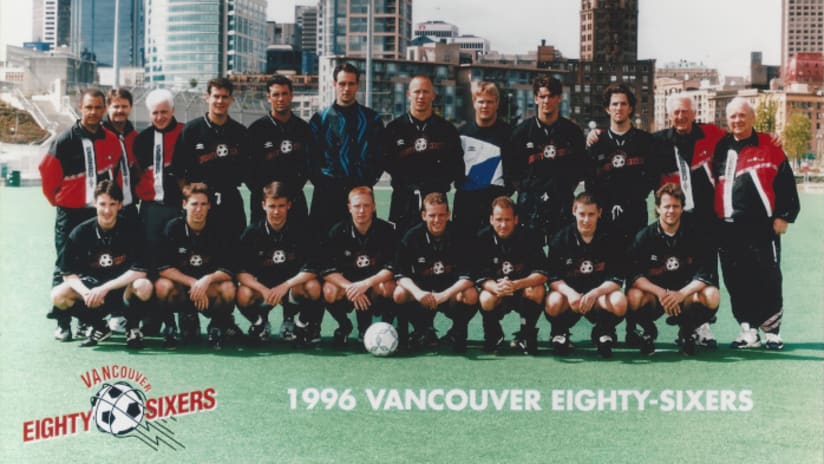Sometimes, there’s more to the beautiful game than meets the eye. Delve deeper with Analysts’ Corner, presented by EC Managed IT, a new blog featuring tactical insights from Whitecaps FC video analyst coach Andrew Peat and assistant video analyst Luke Summers.
[In my best Shelden Rogers voice] What’s up, ‘Caps fans? Luke Summers here!
I’m the assistant video analyst here at Vancouver Whitecaps FC. The majority of my role at the ‘Caps revolves around set plays and I hope to pass on some insight into this area of the game.
For me, set plays are the most unique situations in football in the sense that they’re the only real time you have the majority of control over your opposition. Over the past decade, set plays have grown in relevance, with teams spending more time analyzing and devising plans to create scoring chances.
In this segment, I will talk about the fundamental defensive shapes that teams use to defend corners and the strengths and weaknesses to their set-ups.
MAN-MARKING
Man-marking is the most commonly used defensive shape you will see in football.
As the name implies, it’s a defensive system that matches defenders with attackers with the defender’s sole responsibility to defend the attacker and reduce the space allowed to create opportunities. This doesn’t necessarily mean that teams will match up complete 10v10, however.
In truth, they’re more likely to be mixed with a number of zonal roles given to defenders.
Benefits
The main benefit of this structure is to create matchups with the attacking team.
Typically, an hour before kickoff you’ll find coaches huddled around a whiteboard listing off five or six players from the opposition team then writing their team’s best defenders next to those names. The reason is simple: match my best defenders against your biggest threats. If this all goes to plan, the defender is usually taller and more physical than the attacker and will neutralize the threat.
The other major benefit is the system takes away confusion and less organization is required in the heat of a game. This system makes it “easier” for the defending team to get set up and as the game goes on tired minds need situations to be simple: “You are the man I have to mark, I have to stay with you.”
The third benefit is that it’s an aggressive way of playing. Set plays on both sides of the ball come with a certain level of intimidation and man-marking is a really “in your face” style of defending. The role of the defenders is to be as tight as they can, looking to grab and push attackers (within the laws of the game) making it as hard as possible for them to make clean runs. After a while, attackers gradually become worn down and frustrated with the lack of space available to them.
Often times when defending set plays, your strength is usually your weakness and in man-marking systems this is no different. One of the biggest weaknesses in man-marking set ups is that you can not specifically mark dangerous goal locations.
When man-marking, you’re at the mercy of the movement of the attacking team. Should the attacking team run to the near post, your defenders will run to the near post too. This leaves a large space in the middle of your goal for the opposition to attack. Similarly, teams are coming up with inventive movements and ideas to increase space and opportunities. Tactical blocks and varied movements are all ideas that teams are using to create space and create goalscoring opportunities.
The 1v1 nature of man marking is very reliant on the defender’s ability to execute. Marking a moving target is not an easy task to perform and as a result, losing the opponent is common. Should this happen, there’s no back up or opportunity for another defender to offer help and can lead to big scoring chances.
Lastly, mismatches still occur. Some teams are built with set pieces in mind and can bring forward an offensive unit who are taller and more physical than your team’s defensive unit. Tony Pulis was most famed for this. When managing West Bromwich Albion, he built a tall, aerially threatening team and often created mismatches for the defending team. As I said before, it’s hard to mark a moving target, it’s even harder when trying to defend someone who is physically bigger than you!
Zonal marking has been growing in popularity in recent footballing years and has always been a divisive subject.
I can remember my first interest with zonal marking was when Rafa Benitez implemented the system at Liverpool. The fans and pundits lambasted Liverpool for their system, citing that it was to “easy” for players to get a run on the line. Whether or not that’s true, zonal marking is here to stay.
Zonal marking is the defensive structure that designates zones to players and not specific opposition players. Like man-marking, there are various looks and roles involved within defending zonally and I hope to offer some insight into the most common set-ups.
Benefits
The biggest strength for zonal marking is the ability to have more coverage around the most dangerous areas in the box. By covering the danger zones with defenders, it increases the chance of the defenders being able to put pressure on any movement from the attackers. This reduces the chance quality for the attackers and in theory reduces the goals that you concede.
Another strength is that the defenders always see the ball. Without trying to sound obvious: the ball going into the net gives you a goal, not the attacker. As such, being able to have a clear line of sight on the ball is helpful when defending it. This is different to man-marking as you are more likely to be twisting and turning, watching the attacker.
Lastly, zonal structures are built on the premise that the “whole is greater than the sum of its parts.” The structure is not reliant on one person doing their job, it’s reliant on them all being able to execute together and being able to support each other in defending corners.
In defending this way effectively, it’s very difficult for the opposition to gain clear goal opportunities.
The biggest weakness to zonal structures is they take a lot of understanding, communication, and teamwork to execute. In turn, they take a lot of time to implement on the training field. As mentioned before, the collective is crucial here. Should there be a weakness in any given moment, the zonal structure can be compromised.
Coaches have to spend time being very clear on their players’ roles and responsibilities and in turn the players must have a clear understanding of what is required of them.
Another weakness is that overloads on zones are common. By overloading a zone, this usually means that player(s) are outnumbered by the opposition and are left in situations trying to defend the ball into the box. Typically, teams will try to overload the near post or try to overload weak links in the line.
Lastly, the blockers are crucial to slowing opponents down. Should they fail to do so, the defensive line is exposed and can be overpowered by the attackers. In most zonal structures, it’s important that the blockers do not mark runners. They need to affect as many players as they possibly can. If they “mark” and follow the opposition, then they could expose the line.
The one thing to emphasize is that there’s no “right” way of defending corners. It’s down to the players a coach has at their disposal and their belief in how corners should be defended. Both structures have merits and noticeable flaws. And what it makes it even more tricky: the strength you believe you have in your structure is most likely the exact thing the opposition will try to exploit.




